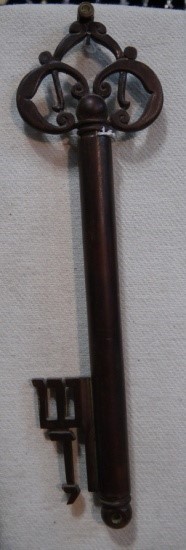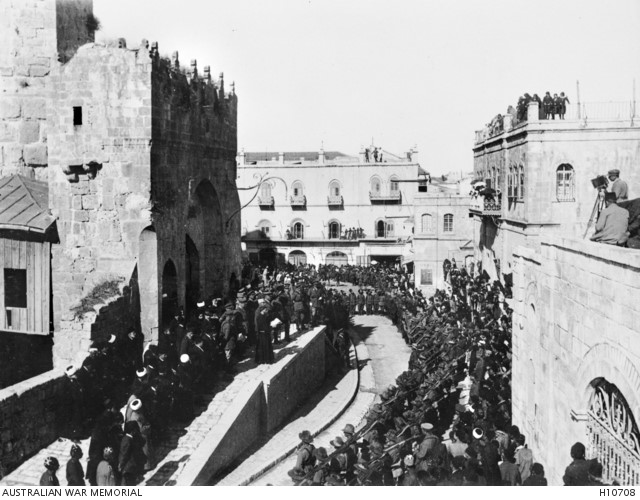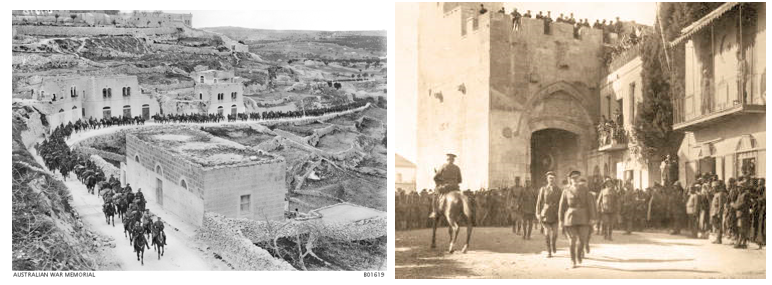The war was still at a stalemate on the Western Front and morale was low in England as winter approached again. ‘Get Jerusalem by Christmas’ was the directive from Prime Minister David Lloyd George to General Allenby. This was sure to boost morale and make for much Christmas joy in Britain and throughout the Christian world.
 Wandering through the immaculately-kept cemetery at Be’er Sheva, one cannot help noticing that there are many graves of those who fell in the days after the Beersheba battle. The battle had been won but the war was not yet over. To the north of Be’er Sheva was a very different landscape. The desert sands gave way to the rocky limestone Judean hills and the rainy season was just beginning. But before it did, the khamsin winds were whipping up sand and stinging the eyes, making breathing and seeing difficult, let alone fighting.
Wandering through the immaculately-kept cemetery at Be’er Sheva, one cannot help noticing that there are many graves of those who fell in the days after the Beersheba battle. The battle had been won but the war was not yet over. To the north of Be’er Sheva was a very different landscape. The desert sands gave way to the rocky limestone Judean hills and the rainy season was just beginning. But before it did, the khamsin winds were whipping up sand and stinging the eyes, making breathing and seeing difficult, let alone fighting.
There was no time for the ANZACs to rest on their laurels and bask in glory as the retreating Turks were quickly re-grouping and the advantage had to be kept. Progress could only be as fast as water was available for people and horses. The Turks had formed a line of defence north of Beersheba and heavy fighting ensued in early November, accounting for the many graves in the Beersheba cemetery. The 2nd Light Horse Brigade continued up the road towards Hebron. Meanwhile, three divisions of the British troops headed for Gaza and this time managed to take the city which finally fell on November 7, 1917. The stronghold of Tel el Khuweilfeh also fell the same day. Day after day the soldiers had to keep fighting, often without adequate water, food or rest. Some British troops were sweeping up the coastal road while others, including the ANZACs, were covering the foothills. As horses were not so useful in this terrain, much of the work was done by the infantry. Progress was slow and exhausting.
 The main attack to break the Turkish line began on November 13. Before Jerusalem could be captured, this cordon had to be broken. On November 14 the New Zealand forces fought a fierce battle at the Arab village of Ayun Kara near the present day Jewish villages of Rishon L’Zion and Rehovot. They lost 44 soldiers with another 141 wounded. On November 15 the ANZACs took Ramle and Lod (biblical Lydda) and were warmly welcomed by the Jewish residents. It was a relief for the troops to finally taste fresh bread and fruit. Lt William James from the 1st Light Horse (NSW) was awarded the Military Cross when he led 40 men to capture 300 Turks near Lod. On November 16 the Australian division took the junction town of Latrun while the New Zealanders took the port city of Jaffa (also called Joppa).
The main attack to break the Turkish line began on November 13. Before Jerusalem could be captured, this cordon had to be broken. On November 14 the New Zealand forces fought a fierce battle at the Arab village of Ayun Kara near the present day Jewish villages of Rishon L’Zion and Rehovot. They lost 44 soldiers with another 141 wounded. On November 15 the ANZACs took Ramle and Lod (biblical Lydda) and were warmly welcomed by the Jewish residents. It was a relief for the troops to finally taste fresh bread and fruit. Lt William James from the 1st Light Horse (NSW) was awarded the Military Cross when he led 40 men to capture 300 Turks near Lod. On November 16 the Australian division took the junction town of Latrun while the New Zealanders took the port city of Jaffa (also called Joppa).
The plains of Philistia were now in British hands and the road to Jerusalem within sight – but it had come at a price. Between November 7 and 16 the British and their allies suffered 10,000 casualties. Most of the dead are buried in the Commonwealth War Graves Cemetery at Ramle.
Jerusalem
The winding road up the hill from Jaffa to Jerusalem has never been simple to conquer. The hills on either side of the road offer cover for snipers who can easily pick off those travelling uphill.
The British fought their way up and finally procured the strategic location of Samuel’s tomb (Nebi Samuel), atop the ridge behind the nearby biblical village of Gibeon, on November 21. Failure to capture this had stopped many would-be conquerors of Jerusalem, including Richard the Lionheart. The 10th Light Horsemen were camped at Artuf and were patrolling as far as Ein Kerem, the birthplace of John the BaptisThere was said to be an Arab prophecy — When the Nile flows into Palestine Al Nebi (God’s Prophet) from the west will drive the Turk from Jerusalem.
These leaflets were signed by Allenby whose name just happens to sound very like Al Nebi! Added to that, the British water pipe from the Nile through the desert had now reached to Palestine.t, eight kilometers from Jerusalem. Storms now made movements more complicated and the Turks were not going to give in easily. With new ground taken, there often came a counter-attack. A stalemate occurred and stopped the advance, so Allenby opted for surrounding Jerusalem and trying to force a withdrawal. It was a touchy political situation, with holy sites which neither side wanted to see destroyed. Aircraft were used to drop leaflets pleading for a surrender.
 On December 8, at 2 am two divisions of the British troops began to fire artillery as they advanced up the Jaffa road to the west of Jerusalem in the final assault. The 10th Light Horse fought their way over to the Jerusalem-Bethlehem road which enters the city from the south, while the Welsh troops met them coming from Hebron, further south. By 5pm the Turks began to panic and by 2 am on December 9 they were streaming out the Jaffa Gate of the Old City of Jerusalem. In the morning a British cook was up early searching for eggs and met the Jerusalem mayor and his delegation looking for the appropriate person to surrender the city too. The word was passed from person to person and finally Brigadier General Watson from the 180th brigade of the 60th Division of the British army met the delegation. General Chetwode, however, had decided that General Shea, commander of the 60th Division should have this honour, so Watson had to return the keys for the ‘official’ surrender.
On December 8, at 2 am two divisions of the British troops began to fire artillery as they advanced up the Jaffa road to the west of Jerusalem in the final assault. The 10th Light Horse fought their way over to the Jerusalem-Bethlehem road which enters the city from the south, while the Welsh troops met them coming from Hebron, further south. By 5pm the Turks began to panic and by 2 am on December 9 they were streaming out the Jaffa Gate of the Old City of Jerusalem. In the morning a British cook was up early searching for eggs and met the Jerusalem mayor and his delegation looking for the appropriate person to surrender the city too. The word was passed from person to person and finally Brigadier General Watson from the 180th brigade of the 60th Division of the British army met the delegation. General Chetwode, however, had decided that General Shea, commander of the 60th Division should have this honour, so Watson had to return the keys for the ‘official’ surrender.
 The 10th Light Horse regiment was the first representative of the Desert Mounted Corp to enter Jerusalem. About 7 pm on December 9 they rode into the city to great jubilation from the local Jewish population who were celebrating the Feast of Dedication (Hanukka). This remembers the Maccabees’ overthrow of the cruel Seleucid Greek rule of Antiochus Epiphanes, and the subsequent re-dedication of the Temple. For the Jews in Jerusalem, another liberation was now unfolding – this time from 400 years of oppression under the Muslim Ottoman regime.
The 10th Light Horse regiment was the first representative of the Desert Mounted Corp to enter Jerusalem. About 7 pm on December 9 they rode into the city to great jubilation from the local Jewish population who were celebrating the Feast of Dedication (Hanukka). This remembers the Maccabees’ overthrow of the cruel Seleucid Greek rule of Antiochus Epiphanes, and the subsequent re-dedication of the Temple. For the Jews in Jerusalem, another liberation was now unfolding – this time from 400 years of oppression under the Muslim Ottoman regime.
December 11, 1917, was the day of the official handover of the city. General Allenby, Commander-in-Chief of the Allied Forces, dismounted his horse and entered by foot, in stark contrast to the flamboyant entry of the German Kaiser Wilhelm II who had visited in 1898. The soldiers formed the guard of honour including 65 ANZACs. The formal reading of the declaration of martial law was read in seven languages from the balcony of the Citadel of David, which dates back to the Romans who drove the Jews from the same city in 70 CE. Ever since then, the Jewish people had been exiled from their land to the four corners of the earth. A new day was dawning.
-----------------------------------

Pictures:
- Commonwealth War Graves cemetery, Be’er Sheva – Jill Curry
- Jaffa – Jill Curry
- Key reputedly made after the design of the key of the city handed over in WW1 – Jill Curry
- Jerusalem surrendered – Australian War Memorial https://www.awm.gov.au/collection/H10708/
- March to Jerusalem, Photographer James Francis (Frank) Hurley – Australian War Memorial https://www.awm.gov.au/collection/B01619/
- Allenby entering Jerusalem 1917– British Official Photograph Q12617, https://en.wikipedia.org/wiki/Battle_of_Jerusalem